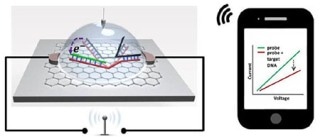Jul 10 2018
A research team led by the University of California San Diego has created a chip that is capable of detecting a type of genetic mutation called a single nucleotide polymorphism (SNP) and wirelessly transmitting the results to a computer, smartphone, or other electronic devices in real time. The chip is at least 1,000 times more sensitive at sensing an SNP than technology currently available.
 Illustration of graphene-based SNP detection chip wirelessly transmitting signal to a smartphone. (Image courtesy of Lal et al.)
Illustration of graphene-based SNP detection chip wirelessly transmitting signal to a smartphone. (Image courtesy of Lal et al.)
The development, reported in the July 9th issue of the Advanced Materials, could pave the way for cheaper, faster, and portable biosensors for early detection of genetic markers for diseases such as cancer.
An SNP is viewed as the change in a single nucleotide base (A, C, G, or T) in the DNA sequence. It is the typical type of genetic mutation. While a majority of SNPs have no noticeable effect on health, a few are linked with increased risk of developing pathological conditions such as diabetes, cancer, neurodegenerative disorders, heart disease, autoimmune and inflammatory diseases.
Traditional SNP detection techniques have several restrictions: they have comparatively poor specificity and sensitivity; they require the use of bulky instruments; they require amplification to obtain many copies for detection; and they cannot function wirelessly.
The new DNA biosensor built by the UC San Diego-led team is a wireless chip measuring smaller than a fingernail, and capable of detecting an SNP that is present in picomolar concentrations in solution.
“Miniaturized chip-based electrical detection of DNA could enable in-field and on-demand detection of specific DNA sequences and polymorphisms for timely diagnosis or prognosis of pending health crises, including viral and bacterial infection-based epidemics.”
Ratnesh Lal, UC San Diego Jacobs School of Engineering, professor of bioengineering, mechanical engineering and materials science
The chip basically captures a strand of DNA comprising a specific SNP mutation and then creates an electrical signal that is transmitted wirelessly to a mobile device. It comprises a graphene field effect transistor with a specially designed piece of double stranded DNA attached to the surface. This piece of DNA is bent near the middle and designed like a pair of tweezers. One side of these “DNA-tweezers” codes for a particular SNP. Every time a DNA strand with that SNP approaches, it binds to that side of the DNA-tweezers, opening them up and causing a change in electrical current that is sensed by the graphene field effect transistor.
The project is headed by Lal and includes teams at the Institute of Engineering in Medicine at UC San Diego, Chinese Academy of Sciences in China, University of Pennsylvania, Max Planck Institute for Biophysical Chemistry in Germany, and Inner Mongolia Agricultural University in China.
DNA strand displacement
What stimulates this technology is a molecular process known as DNA strand displacement—where a DNA double helix exchanges one of its strands for a new complementary strand. Here, the DNA-tweezers switch one their strands for one with a specific SNP.
This is possible because of the particular way the DNA-tweezers are designed. One of the strands is a “normal” strand that is bound to the graphene transistor and comprises the complementary sequence for a specific SNP. The other is a “weak” strand in which a few of the nucleotides are substituted with a different molecule to weaken its bonds to the normal strand. A strand comprising the SNP is able to attach more strongly to the normal strand and dislodge the weak strand. This leaves the DNA-tweezers with a net electric charge that can be easily sensed by the graphene transistor.
New and improved SNP detection chip
This research is based upon the first label- and amplification-free electronic SNP detection chip that Lal’s team formerly developed in partnership with Gennadi Glinksy, a research scientist at the UC San Diego Institute of Engineering in Medicine, and other UC San Diego researchers. The new chip has an additional wireless capability and is at best 1,000 times more sensitive than its predecessor.
The design of the DNA-tweezers is what makes the new chip highly sensitive. When the SNP-containing strand attaches, it opens up the DNA-tweezers, altering their geometry so that they become virtually parallel to the graphene surface. This brings the net electric charge of the DNA near the graphene surface, delivering a larger signal. In contrast, the DNA probe embedded into the earlier chip has a structure that cannot be brought near the graphene surface, so it creates a weaker signal upon binding an SNP-containing strand.
Going forward, the researchers plan to design array chips capable of detecting up to numerous SNPs in a single test. Future studies will also involve testing the chip on blood and other bodily fluid samples taken from humans or animals.